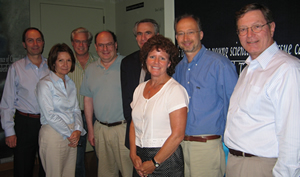The Search for a Cure—Why Now?
November 17, 2010— When amfAR announced a major new research initiative in February targeting a cure for HIV/AIDS, a question quickly arose: Hasn’t amfAR always been looking for a cure?
The short answer is no. Basic research in the early years of the epidemic was driven by the desperate need to develop treatments that could keep people alive. As that effort bore fruit, the focus shifted to a preventive vaccine—the new holy grail of AIDS research. Then in the late 1990s, amfAR was among the first to invest in the development of a preventive microbicide.
While amfAR has never lost sight of a cure as an ultimate goal, the scientific obstacles remain formidable. “So far there is no evidence that HIV can be cleared by drugs or the immune system, largely because the virus persists in reservoirs, contributing to the belief held by many, if not most AIDS researchers, that a cure for HIV infection is and may always be impossible,” wrote Dr. Rowena Johnston, amfAR’s vice president and director of research, in the July issue of AIDS Research and Human Retroviruses.
Skepticism among scientists about the feasibility of a cure is also rooted in the stunning success of highly active antiretroviral therapy (HAART). Its game-changing efficacy initially led some researchers to make rash predictions about the prospects for a cure. But as scientific roadblocks continued to confound their efforts, many scientists became reluctant to even mention the word.
For the last decade, however, amfAR has demonstrated a steadfast commitment to cure research. “Since 2002, we’ve invested about 40 percent of our research budget in 50 cure-focused research projects,” said amfAR CEO Kevin Robert Frost. This is in stark contrast to the federal government, which spent less than three percent of its total 2009 AIDS research budget for research in this area.

Members of amfAR’s cure consortium: (L to R) Rick Hecht, Janice Clements, Mike McCune, Jonathan Karn (observer), Robert Siliciano, Sarah Palmer, Steve Deeks, and John Zaia
|
Several factors have led to a significant shift in thinking over the last two years. First, it’s increasingly clear that the economics of treatment just don’t add up. Even with a monumental international effort to expand access to treatment, at the end of 2008 only 42 percent of those in need were receiving it. Moreover, HIV/AIDS funding continues to fall short of the need; in 2009, a total of $23.6 billion was needed to meet prevention and treatment goals, but only $15.9 billion was available. The total investments required for 2010 were estimated at $25.1 billion. And for every person put on treatment, two to three more are infected with HIV.
Meanwhile, scientific advances have created a groundswell of optimism about a cure. In part, this stems from a report in February 2009 involving an HIV-positive American living in Berlin, now dubbed the Berlin patient, who was diagnosed with acute leukemia. To treat the cancer, he received a stem cell transplant, but his doctors took an extra step, finding a donor with a genetic mutation known as CCR5 delta-32, which makes individuals highly resistant to HIV infection. By transplanting cells from the donor, doctors hoped that they might also eradicate the patient’s HIV infection.
After almost three years, the Berlin patient continues to show no detectable signs of HIV. At the very least he represents a functional cure. But the complexity, risk, and expense of the procedure render it impractical, and the chance of replicating it was recently estimated to be approximately one in 10 million, according to Dr. Johnston. Still, this breakthrough case opens the door to further research that could yield key answers.
Speaking at the 2010 Conference on Retroviruses and Opportunistic Infections, Dr. Anthony Fauci, director of the National Institute of Allergy and Infectious Diseases at the National Institutes of Health, embraced the possibility of a cure and the need to actively pursue one. “I feel strongly that this is a direction we should go,” he said, “even though years ago this would have been unimaginable.”
“There are clearly many scientific issues that need to be addressed before a cure for HIV infection is likely, and few on which there is universal consensus,” wrote Dr. Johnston in AIDS Research and Human Retroviruses. “But these are all amenable to research, and may benefit from a collective effort involving the productive collaboration of a number of research groups with different perspectives and skill sets…. The effort will surely necessitate a willingness to cast aside self-defeating notions of the impossibility of the task and to replace those with creativity and perseverance.”
To read more about the amfAR Research Consortium on HIV Eradication, click here.
Related stories:
Gene Therapy and the Potential for an HIV Cure
Reducing HIV Growth to Zero
In Search of a Cure: Working to Turn on HIV